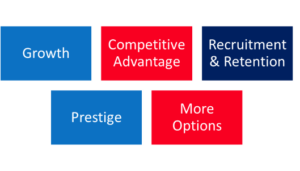WHY TAKE YOUR COMPANY PUBLIC ON A STOCK EXCHANGE?
A growing company needs access to both working capital and expansion capital. Whether it is bank loans, subordinated debt, seed capital, venture capital, investment financing that access to capital must be realistic and achievable. Without access to capital even the most “self-funding” business will fail to develop to its full potential. If you’re look to have your company go public on a stock exchange find out why first. This pages describes the benefits of a stock exchange listing for you and your shareholders.
What makes the decision to become a publicly traded company the right one over the many other means of financing a business?
Going public may be the result of a long-term strategy for an organization that is growing and requires access to larger capital markets. Alternatively, you may be an entrepreneur with a promising young business founded upon an excellent idea. You have already built some shareholder value and are looking for leverage to get to the next step. Most founder’s borrowing capabilities have been quickly exhausted when devoted to financing a demanding start-up company. The public equity markets offer you untold numbers of new investors, and access to the crucial investment capital your company requires.
Founders have built many successful companies without going public. However, as part of an exit strategy or succession plan many business leaders have seen that it makes perfect sense to go public on a recognized stock exchange.
WHAT ARE THE BENEFITS OF TAKING YOUR COMPANY PUBLIC?
A stock exchange listing offers key strategic advantages including:
Growth – It can increase your company’s equity base and create more leverage for financing growth through acquisitions. 
More Options – You may opt to finance an acquisition with common shares and avoid incurring additional debt or selling assets to finance the deal.
Competitive Advantage –You can finance your full business plan and implement the changes and improvement. As a result, this will win you a competitive advantage or access to international markets.
Employee Retention and Recruitment –You can provide an employee retention program that works through a stock-based compensation strategy. Therefore, helping you to attract and keep your best people.
Prestige –Through heightened public awareness, your company will increase its prestige. As well as acquire much greater recognition, which can help your business.
While your planning process should always consider other sources of financing in addition to going public, it is wise to build a strategic business plan. In addition, it should highlight the inherent benefits of gaining access to the Canadian capital markets.
WHAT’S IN IT FOR YOUR SHAREHOLDERS?
To determine the share price of your company, there are several factors to consider:
- The market’s perception of your management team and their business acumen.
- Your business track record.
- Your business momentum and an estimation of your continuing potential.
- The size and long-term prospects for the market you are selling into.
Since people invest for the purpose of realizing growth and returns that are better than other investment opportunities. Therefore, you and your management team responsible to consistently building shareholder value through profitable corporate growth.
GOING PUBLIC IS EASIER THAN YOU THINK…
Before deciding to go public, you should assess the impact it will have on you and your company. Then decide whether you are ready to make the necessary commitment before, during and after the initial public offering process. The good news is that access to the public capital markets may be much easier than you think.
After you become a public company, investors and securities regulators will expect timely and relevant information about your business and its prospects. As a public company, you must provide information to the public that may be sensitive. This includes, operating results for business segments, compensation of officers, and other material facts.
Depending on where you list, a stock exchange listing need not be a daunting task. However, the steps must be well planned. The typical process includes:
- Developing a strategy
- Planning and coordinating the process
- Preparing, finalizing and executing the prospectus – if necessary.
- Identifying a suitable RTO (Reverse Takeover) vehicle – if necessary.
- Completing the transaction and continuing as a public company.
If you are looking at taking your company public and would like to learn more about how and why, please contact us. You can fill out the form to the right of this page and a member of our team will contact you shortly.

